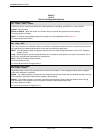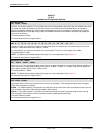
COMSPHERE 3821Plus Modem
3-36 February 1998 3821-A2-GB20-30
Table 3-7
(3 of 3)
Dial Line Configuration Options
V22b Guard Tone: Disable
Nxt Disable 550Hz 1800Hz
V.22bis Guard Tone. Determines whether the V.22bis guard tone is disabled, set to 550 Hz, or set to 1800 Hz.
Disable – No guard tone.
550 Hz or 1800 Hz – When the modem is in Answer mode, it transmits the guard tone at this frequency.
The factory default is Disable.
NOTE: The default and permitted settings of this option are country-dependent. See Appendix H.
AT command equivalent is &G
n
.
Train Time: Long
Nxt Long Short
Train Time. Controls V.34, V.32
terbo
, V.32bis, and V.32 train. Determines whether minimum or maximum time durations
are used during the handshaking sequence for both dial and leased line applications.
NOTE: This configuration option only appears when the Dial Line Rate configuration option is set for V.34, V.32
terbo
,
V.32bis, or V.32.
Long – Selects long train. Use this setting whenever far-end frequency offset (phase roll) may be encountered. This is
usually only required when transmitting over satellite links.
Short – Allows the modem to train-up faster.
The factory default is Long.
AT command equivalent is S-register S43=
n
.
Asymmetric Rate: Enable
End Enable Disable
Asymmetric Rate. Controls rate symmetry when running V.34 modulation. (This configuration option does not appear
unless V.34 modulation is selected.)
Enable – The modem operates in asymmetric rate mode (the transmit and receive rates can be different) when running
V.34 modulation. Asymmetric Rate must be enabled in both modems.
Disable – The modem operates in symmetric rate mode (the transmit and receive rates are identical) when running
V.34 modulation. Either modem can force symmetric mode by disabling Asymmetric Rate.
The factory default is Enable.
AT command equivalent is S-register S14=
n
.


















